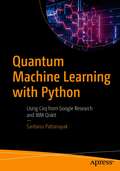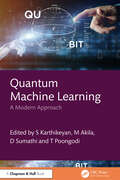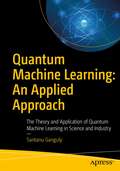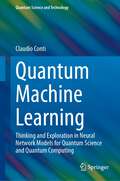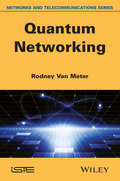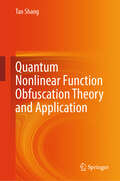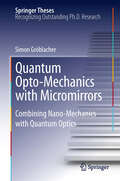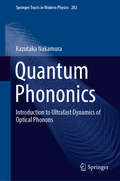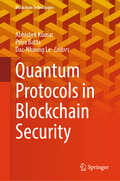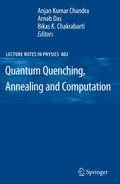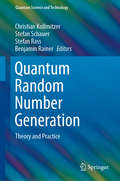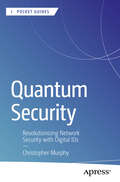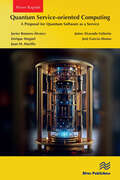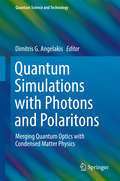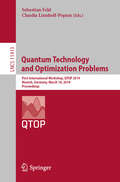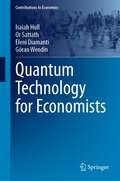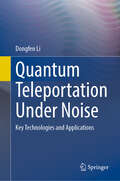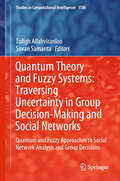- Table View
- List View
Quantum Machine Learning with Python: Using Cirq from Google Research and IBM Qiskit
by Santanu PattanayakQuickly scale up to Quantum computing and Quantum machine learning foundations and related mathematics and expose them to different use cases that can be solved through Quantum based algorithms.This book explains Quantum Computing, which leverages the Quantum mechanical properties sub-atomic particles. It also examines Quantum machine learning, which can help solve some of the most challenging problems in forecasting, financial modeling, genomics, cybersecurity, supply chain logistics, cryptography among others.You'll start by reviewing the fundamental concepts of Quantum Computing, such as Dirac Notations, Qubits, and Bell state, followed by postulates and mathematical foundations of Quantum Computing. Once the foundation base is set, you'll delve deep into Quantum based algorithms including Quantum Fourier transform, phase estimation, and HHL (Harrow-Hassidim-Lloyd) among others. You'll then be introduced to Quantum machine learning and Quantum deep learning-based algorithms, along with advanced topics of Quantum adiabatic processes and Quantum based optimization. Throughout the book, there are Python implementations of different Quantum machine learning and Quantum computing algorithms using the Qiskit toolkit from IBM and Cirq from Google Research.What You'll LearnUnderstand Quantum computing and Quantum machine learningExplore varied domains and the scenarios where Quantum machine learning solutions can be appliedDevelop expertise in algorithm development in varied Quantum computing frameworksReview the major challenges of building large scale Quantum computers and applying its various techniquesWho This Book Is ForMachine Learning enthusiasts and engineers who want to quickly scale up to Quantum Machine Learning
Quantum Machine Learning: A Modern Approach
by T. Poongodi D. Sumathi S. Karthikeyan M. AkilaThis book presents the research into and application of machine learning in quantum computation, known as quantum machine learning (QML). It presents a comparison of quantum machine learning, classical machine learning, and traditional programming, along with the usage of quantum computing, toward improving traditional machine learning algorithms through case studies.In summary, the book: Covers the core and fundamental aspects of statistics, quantum learning, and quantum machines. Discusses the basics of machine learning, regression, supervised and unsupervised machine learning algorithms, and artificial neural networks. Elaborates upon quantum machine learning models, quantum machine learning approaches and quantum classification, and boosting. Introduces quantum evaluation models, deep quantum learning, ensembles, and QBoost. Presents case studies to demonstrate the efficiency of quantum mechanics in industrial aspects. This reference text is primarily written for scholars and researchers working in the fields of computer science and engineering, information technology, electrical engineering, and electronics and communication engineering.
Quantum Machine Learning: The Theory and Application of Quantum Machine Learning in Science and Industry
by Santanu GangulyKnow how to adapt quantum computing and machine learning algorithms. This book takes you on a journey into hands-on quantum machine learning (QML) through various options available in industry and research.The first three chapters offer insights into the combination of the science of quantum mechanics and the techniques of machine learning, where concepts of classical information technology meet the power of physics. Subsequent chapters follow a systematic deep dive into various quantum machine learning algorithms, quantum optimization, applications of advanced QML algorithms (quantum k-means, quantum k-medians, quantum neural networks, etc.), qubit state preparation for specific QML algorithms, inference, polynomial Hamiltonian simulation, and more, finishing with advanced and up-to-date research areas such as quantum walks, QML via Tensor Networks, and QBoost.Hands-on exercises from open source libraries regularly used today in industry and research are included, such as Qiskit, Rigetti's Forest, D-Wave's dOcean, Google's Cirq and brand new TensorFlow Quantum, and Xanadu's PennyLane, accompanied by guided implementation instructions. Wherever applicable, the book also shares various options of accessing quantum computing and machine learning ecosystems as may be relevant to specific algorithms.The book offers a hands-on approach to the field of QML using updated libraries and algorithms in this emerging field. You will benefit from the concrete examples and understanding of tools and concepts for building intelligent systems boosted by the quantum computing ecosystem. This work leverages the author’s active research in the field and is accompanied by a constantly updated website for the book which provides all of the code examples.What You will Learn Understand and explore quantum computing and quantum machine learning, and their application in science and industry Explore various data training models utilizing quantum machine learning algorithms and Python libraries Get hands-on and familiar with applied quantum computing, including freely available cloud-based access Be familiar with techniques for training and scaling quantum neural networks Gain insight into the application of practical code examples without needing to acquire excessive machine learning theory or take a quantum mechanics deep dive Who This Book Is ForData scientists, machine learning professionals, and researchers
Quantum Machine Learning: Thinking and Exploration in Neural Network Models for Quantum Science and Quantum Computing (Quantum Science and Technology)
by Claudio ContiThis book presents a new way of thinking about quantum mechanics and machine learning by merging the two. Quantum mechanics and machine learning may seem theoretically disparate, but their link becomes clear through the density matrix operator which can be readily approximated by neural network models, permitting a formulation of quantum physics in which physical observables can be computed via neural networks. As well as demonstrating the natural affinity of quantum physics and machine learning, this viewpoint opens rich possibilities in terms of computation, efficient hardware, and scalability. One can also obtain trainable models to optimize applications and fine-tune theories, such as approximation of the ground state in many body systems, and boosting quantum circuits’ performance. The book begins with the introduction of programming tools and basic concepts of machine learning, with necessary background material from quantum mechanics and quantum information also provided. This enables the basic building blocks, neural network models for vacuum states, to be introduced. The highlights that follow include: non-classical state representations, with squeezers and beam splitters used to implement the primary layers for quantum computing; boson sampling with neural network models; an overview of available quantum computing platforms, their models, and their programming; and neural network models as a variational ansatz for many-body Hamiltonian ground states with applications to Ising machines and solitons. The book emphasizes coding, with many open source examples in Python and TensorFlow, while MATLAB and Mathematica routines clarify and validate proofs. This book is essential reading for graduate students and researchers who want to develop both the requisite physics and coding knowledge to understand the rich interplay of quantum mechanics and machine learning.
Quantum Mechanics for Pedestrians 1: Fundamentals (Undergraduate Lecture Notes in Physics)
by Jochen PadeThis book, the first in a two-volume set, provides an introduction to the fundamentals of (mainly) non-relativistic quantum mechanics. This first volume chiefly focuses on the essential principles, while applications and extensions of the formalism can be found in volume 2. Including but also moving beyond material that is covered in traditional textbooks on quantum mechanics, the book discusses in detail current issues such as interaction-free quantum measurements or neutrino oscillations, as well as fundamental problems and epistemological questions, such as the measurement problem. A chapter on the postulates of quantum mechanics rounds off this first volume. In order to quickly and clearly present the main principles of quantum mechanics and its mathematical formulation, there is a systematic transition between wave mechanics and algebraic representation in the first few chapters, in which the required mathematical tools are introduced step by step. Moreover, the appendix concisely reviews the most important mathematical tools, allowing readers to largely dispense with supplementary literature. The appendix also explores advanced topics, such as the Quantum-Zeno effect and time-delay experiments. Over 250 exercises, most of them with solutions, help to deepen the reader’s understanding of the topics discussed. This revised second edition is expanded by an introduction to some ideas and problems of relativistic quantum mechanics. In this first volume, the Klein-Gordon and the Dirac equations are treated. Fundamentals of other areas are compiled in compact form, i.e., outlines of special relativity, classical field theory and electrodynamics. The book is chiefly intended for student science teachers and all students of physics, majors and minors alike, who are looking for a reasonably easy and modern introduction to quantum mechanics.
Quantum Mechanics for Pedestrians 2: Applications and Extensions (Undergraduate Lecture Notes in Physics)
by Jochen PadeThis book, the second in a two-volume set, provides an introduction to the basics of (mainly) non-relativistic quantum mechanics. While the first volume addresses the basic principles, this second volume discusses applications and extensions to more complex problems. In addition to topics dealt with in traditional quantum mechanics texts, such as symmetries or many-body problems, it also treats issues of current interest such as entanglement, Bell’s inequality, decoherence and various aspects of quantum information in detail. Furthermore, questions concerning the basis of quantum mechanics and epistemological issues which are relevant e.g. to the realism debate are discussed explicitly. A chapter on the interpretations of quantum mechanics rounds out the book. Readers are introduced to the requisite mathematical tools step by step. In the appendix, the most relevant mathematics is compiled in compact form, and more advanced topics such as the Lenz vector, Hardy’s experiment and Shor’s algorithm are treated in more detail. As an essential aid to learning and teaching, 130 exercises are included, most of them with solutions. This revised second edition is expanded by an introduction into some ideas and problems of relativistic quantum mechanics. In this second volume, an overview of quantum field theory is given and basic conceptions of quantum electrodynamics are treated in some detail. Originally written as a course for students of science education, the book addresses all those science students and others who are looking for a reasonably simple, fresh and modern introduction to the field.
Quantum Metrology, Imaging, and Communication
by Gregg Jaeger David S. Simon Alexander V. SergienkoThis book describes the experimental and theoretical bases for the development of specifically quantum-mechanical approaches to metrology, imaging, and communication. In particular, it presents novel techniques developed over the last two decades and explicates them both theoretically and by reference to experiments which demonstrate their principles in practice. The particular techniques explored include two-photon interferometry, two-photon optical aberration and dispersion cancellation, lithography, microscopy, and cryptography.
Quantum Networking
by Rodney Van MeterQuantum networks build on entanglement and quantum measurement to achieve tasks that are beyond the reach of classical systems. Using quantum effects, we can detect the presence of eavesdroppers, raise the sensitivity of scientific instruments such as telescopes, or teleport quantum data from one location to another. Long-distance entanglement can be used to execute important tasks such as Byzantine agreement and leader election in fewer rounds of communication than classical systems, improving the efficiency of operations that are critical in distributed systems.
Quantum Nonlinear Function Obfuscation Theory and Application
by Tao ShangThis book summarizes the main research results and preliminaries of quantum obfuscation and systematically introduces quantum obfuscation methods. Quantum obfuscation is an important and cross-cutting research topic in quantum cryptography and quantum computation. Quantum cryptography and quantum computation have made great progress in this century. However, academic research on the theory of quantum obfuscation is still at a blank stage. The author combines the theory of quantum computation and obfuscation and develop the theory of quantum obfuscation. Until now, a series of representative schemes have been proposed. From the viewpoint of quantum nonlinear function obfuscation, the author designs a series of quantum obfuscation schemes by means of combining obfuscation theory with quantum computation. Furthermore, the author describes the quantum cryptographic protocols based on quantum obfuscation. These methods will provide effective tools for the research and application of quantum cryptography.
Quantum Objects: Non-Local Correlation, Causality and Objective Indefiniteness in the Quantum World
by Gregg JaegerThis monograph identifies the essential characteristics of the objects described by current quantum theory and considers their relationship to space-time. In the process, it explicates the senses in which quantum objects may be consistently considered to have parts of which they may be composed or into which they may be decomposed. The book also demonstrates the degree to which reduction is possible in quantum mechanics, showing it to be related to the objective indefiniteness of quantum properties and the strong non-local correlations that can occur between the physical quantities of quantum subsystems. Careful attention is paid to the relationships among such property correlations, physical causation, probability, and symmetry in quantum theory. In this way, the text identifies and clarifies the conceptual grounds underlying the unique nature of many quantum phenomena.
Quantum Opto-Mechanics with Micromirrors
by Simon GröblacherQuantum effects in macroscopic systems have long been a fascination for researchers. Over the past decade mechanical oscillators have emerged as a leading system of choice for many such experiments. The work reported in this thesis investigates the effects of the radiation-pressure force of light on macroscopic mechanical structures. The basic system studied is a mechanical oscillator that is highly reflective and part of an optical resonator. It interacts with the optical cavity mode via the radiation-pressure force. Both the dynamics of the mechanical oscillation and the properties of the light field are modified through this interaction. The experiments use quantum optical tools (such as homodyning and down-conversion) with the goal of ultimately showing quantum behavior of the mechanical center of mass motion. Of particular value are the detailed descriptions of several novel experiments that pave the way towards this goal and are already shaping the field of quantum optomechanics, in particular optomechanical laser cooling and strong optomechanical coupling.
Quantum Phononics: Introduction to Ultrafast Dynamics of Optical Phonons (Springer Tracts in Modern Physics #282)
by Kazutaka NakamuraThis book presents quantum phononics as an exciting new field of research, and introduces readers to the quantum nature of phonons and their application to quantum technologies. Both the theory of and recent experiments in “quantum phononics,” involving e.g. coherent phonons, phonon squeezing, coherent control, and phonon quantum technologies, are presented. The theoretical background of the generation and detection of phonons is described in a way that will be easy to understand for graduate students and experimental scientists who are newcomers to the field. Moreover, the book focuses on coherent phonons produced by ultrafast laser pulses, which can be used for the coherent control of atomic motions in solids and phase transformation. The laser-matter interaction is treated using a density matrix formalism of the time-dependent Schröedinger equation. In addition, the third-order nonlinear optical response of condensed matter is also described.
Quantum Physics for Scientists and Technologists
by Paul SangheraQuantum Physics for Scientists and Technologists is a self-contained, comprehensive review of this complex branch of science. The book demystifies difficult concepts and views the subject through non-physics fields such as computer science, biology, chemistry, and nanotechnology. It explains key concepts and phenomena in the language of non-physics majors and with simple math, assuming no prior knowledge of the topic.This cohesive book begins with the wavefunction to develop the basic principles of quantum mechanics such as the uncertainty principle and wave-particle duality. Comprehensive coverage of quantum theory is presented, supported by experimental results and explained through applications and examples without the use of abstract and complex mathematical tools or formalisms. From there, the book:Takes the mystery out of the Schrodinger equation, the fundamental equation of quantum physics, by applying it to atomsShows how quantum mechanics explains the periodic table of elementsIntroduces the quantum mechanical concept of spin and spin quantum number, along with Pauli's Exclusion Principle regarding the occupation of quantum statesAddresses quantum states of molecules in terms of rotation and vibration of diatomic moleculesExplores the interface between classical statistical mechanics and quantum statistical mechanicsDiscusses quantum mechanics as a common thread through different fields of nanoscience and nanotechnologyEach chapter features real-world applications of one or more quantum mechanics principles. "Study Checkpoints" and problems with solutions are presented throughout to make difficult concepts easy to understand. In addition, pictures, tables, and diagrams with full explanations are used to present data and further explain difficult concepts.This book is designed as a complete course in quantum mechanics for senior undergraduates and first-year graduate students in non-physics majors. It also applies to courses such as modern physics, physical chemistry and nanotechnology. The material is also accessible to scientists, engineers, and technologists working in the fields of computer science, biology, chemistry, engineering, and nanotechnology.
Quantum Programming in Depth: Solving problems with Q# and Qiskit
by Mariia MykhailovaGo beyond the basics with this in-depth guide to quantum programming.Here&’s something you already know: quantum computing is a deep subject. Quantum Programming in Depth takes you beyond quantum basics and shows you how to take on practical quantum problem solving and programming using Q# and Qiskit. Author Mariia Mykhailova, a principal quantum applications software developer at PsiQuantum, guides you every step of the way. In Quantum Programming in Depth you&’ll explore: • Algorithms to solve challenging quantum computing problems • Writing quantum programs with Q# and Qiskit • Testing quantum programs with simulators and specialized tools • Evaluating performance of quantum programs on future fault-tolerant quantum computers Quantum Programming in Depth shows you how to do quantum computing outside the lab or classroom, presenting problems of quantum programming and demonstrating how they&’re solved. You&’ll learn to write quantum programs using Qiskit and Q#—and even how to test your quantum code using common testing tools like pytest. You&’ll learn to prepare quantum states and implement operations, extract information from quantum states and operations, evaluate classical functions on a quantum computer, solve search problems, and more. About the Technology Going from the basic quantum concepts to developing software for quantum computers can be difficult! Algorithms that leverage quantum phenomena require new ways of thinking about computation and new approaches to writing code, testing it, and evaluating its performance. This book bridges the gap between QC theory and quantum programming in practice. About the Book Quantum Programming in Depth shows you how to solve quantum computing problems in a programmer-friendly way. The book&’s hands-on project-based approach will hone your quantum skills using realistic problems and progressively harder programming challenges. As you read, you&’ll design quantum algorithms and explore their performance on future fault-tolerant quantum computers. What&’s Inside • Solve challenging quantum computing problems • Write quantum programs with Q# and Qiskit • Test quantum programs • Evaluate performance of quantum programs About the Readers For students and software engineers who know Python and the basic concepts of quantum computing. About the Author Mariia Mykhailova is a principal quantum applications software developer at PsiQuantum. Table of Contents 1 Quantum computing: The hype and the promise Part 1 2 Preparing quantum states 3 Implementing quantum operations Part 2 4 Analyzing quantum states 5 Analyzing quantum operations Part 3 6 Evaluating classical functions on a quantum computer 7 Grover&’s search algorithm 8 Solving N queens puzzle using Grover&’s algorithm 9 Evaluating the performance of quantum algorithms A Setting up your environment
Quantum Protocols in Blockchain Security (Blockchain Technologies)
by Abhishek Kumar Dac-Nhuong Le Priya BattaThis book highlights the intersection of quantum computing and blockchain technology, addressing the urgent need for enhanced security measures in a post-quantum world. This book provides a comprehensive overview of fundamental quantum concepts, the vulnerabilities of classical cryptography, and the innovative solutions that quantum protocols offer. Each chapter delves into topics such as quantum key distribution, post-quantum cryptography, and secure smart contracts, highlighting real-world applications and challenges in implementing decentralized quantum networks. By merging theoretical insights with practical strategies, this book equips researchers, developers, and industry professionals.
Quantum Quenching, Annealing and Computation
by Bikas K. Chakrabarti Arnab Das Anjan Kumar ChandraThe process of realizing the ground state of some typical (frustrated) quantum many-body systems, starting from the 'disordered' or excited states, can formally be mapped onto the search of solutions for computationally hard problems. The dynamics through quantum critical points are especially crucial in the context of such computational optimization problems and have been investigated intensively in recent times. Several successful methods are now well-established, and this volume compiles a collection of introductory reviews on such developments and related aspects. Written by well known experts, these lectures concentrate on quantum phase transitions and their dynamics as the transition or critical points are crossed. Both the quenching and annealing dynamics are extensively covered. The style has been kept as tutorial as possible in order to make this volume a suitable reference for young researchers joining this exciting and burgeoning field of research.
Quantum Random Number Generation: Theory and Practice (Quantum Science and Technology)
by Stefan Rass Stefan Schauer Christian Kollmitzer Benjamin RainerThis book provides an overview of state-of-the-art implementations of quantum random number generators (QRNGs), and especially examines their relation to classical statistical randomness models and numerical techniques for computing random numbers. The reader – who ideally has a background in classical statistics, computer science, or cryptography – is introduced to the world of quantum bits step by step, and explicit relations between QRNGs and their classical counterparts are identified along the way. Random number generation is a major pillar of cryptography. Capitalizing on the randomness inherent in quantum phenomena is a rapidly evolving branch of quantum cryptography with countless applications for the future. The value of quantum randomness for cryptographic purposes is empirically demonstrated in statistical evaluations of QRNGs’ performance compared to classical techniques for true and pseudorandom number generation. The book then provides an overview of technical implementations of QRNGs, before a concluding discussion of major achievements and remaining obstacles in the field rounds out the coverage, while also opening the door for future research directions.
Quantum Security: Revolutionizing Network Security with Digital IDs (Apress Pocket Guides)
by Christopher MurphyIn a world where cybersecurity threats evolve daily, it’s time to leave traditional, flawed security models behind. This book introduces a groundbreaking approach that applies the quantum principle of superposition to user authentication. Just as a particle exists in multiple states until observed, a user’s presence on a network remains undefined until their Digital ID is verified. Once verified, their identity collapses into a single truth—eliminating any risk of impersonation or fraud. This book demonstrates how Digital IDs transform the very foundation of network security. Unlike conventional methods, where user identity is indirectly represented through data, this model ties a user’s existence directly to their Digital ID. By securing user presence—and absence—this new authentication model offers unparalleled protection from unauthorized access and common cyber threats like stolen credentials or malicious impersonation. It equips cybersecurity professionals, C-suite executives, and decision-makers with practical, actionable steps for seamlessly integrating this new technology into existing infrastructures. Readers will explore how Digital IDs create a secure, private interface when connected to the network, and how they prevent unauthorized actions when the user is absent. This innovative shift moves security from reactive mitigation strategies to proactive solutions that ensure both trust and control. What You Will Learn: The difference between indirect and direct authentication and how the current cybersecurity approach is fundamentally flawed. Practical steps for implementing digital IDs and direct user interaction to eliminate common cyber threats. How to shift from reactive mitigation strategies to proactive, long-term security solutions that significantly reduce vulnerabilities. Straightforward, actionable insights on how to transform current cybersecurity infrastructures for more robust protection. Who This Book is for: This book is written primarily for cybersecurity professionals such as CISOs, CTOs, CIOs, network architects, and IT security managers. These readers have a deep understanding of current cybersecurity challenges but are seeking innovative, more effective solutions to overcome systemic flaws in today’s network security models. Secondary audiences include business leaders and decision-makers in organizations, who need to understand the strategic importance of cybersecurity innovations like Digital IDs and Direct User Interaction. Tertiary audiences might include students or researchers in cybersecurity who want to explore alternative security models.
Quantum Service-oriented Computing: A Proposal for Quantum Software as a Service
by Juan M. Murillo Enrique Moguel Javier Romero-Álvarez Jaime Alvarado-Valiente José Garcia-AlonsoThis book is an analysis of quantum computing, covering everything from its foundational principles to practical applications in the development of quantum services. It offers a technical and complex overview to provide the necessary knowledge to any researcher, scientist or developer who wants to get into service-oriented quantum computing.The field of quantum computing has evolved rapidly in recent years, with the potential to revolutionize the way we approach complex problems in various fields. This comprehensive guide covers the fundamental principles of quantum computing and its practical applications in the development of quantum services.Beyond theoretical knowledge, the book goes on to explore some of the challenges that quantum software developers face in today’s landscape. It addresses issues related to low-level abstractions and the absence of integration, deployment and quality assurance mechanisms in quantum software engineering. Also, it explores the principles of service-oriented computing applied to quantum computing, revealing architectural patterns adapted to quantum computing and discussing standardization and accessibility in this field. It also provides insight into streamlining the deployment process through a DevOps approach for continuous deployment of quantum services.This book will serve as a guide for all researchers, scientists and developers by providing them with an understanding of the current limitations and problems in quantum computing-oriented software development, and how to address them with software engineering techniques and tools applied to quantum computing.
Quantum Simulations with Photons and Polaritons
by Dimitris G. AngelakisThis book reviews progress towards quantum simulators based on photonic and hybrid light-matter systems, covering theoretical proposals and recent experimental work. Quantum simulators are specially designed quantum computers. Their main aim is to simulate and understand complex and inaccessible quantum many-body phenomena found or predicted in condensed matter physics, materials science and exotic quantum field theories. Applications will include the engineering of smart materials, robust optical or electronic circuits, deciphering quantum chemistry and even the design of drugs. Technological developments in the fields of interfacing light and matter, especially in many-body quantum optics, have motivated recent proposals for quantum simulators based on strongly correlated photons and polaritons generated in hybrid light-matter systems. The latter have complementary strengths to cold atom and ion based simulators and they can probe for example out of equilibrium phenomena in a natural driven-dissipative setting. This book covers some of the most important works in this area reviewing the proposal for Mott transitions and Luttinger liquid physics with light, to simulating interacting relativistic theories, topological insulators and gauge field physics. The stage of the field now is at a point where on top of the numerous theory proposals; experiments are also reported. Connecting to the theory proposals presented in the chapters, the main experimental quantum technology platforms developed from groups worldwide to realize photonic and polaritonic simulators in the laboratory are also discussed. These include coupled microwave resonator arrays in superconducting circuits, semiconductor based polariton systems, and integrated quantum photonic chips. This is the first book dedicated to photonic approaches to quantum simulation, reviewing the fundamentals for the researcher new to the field, and providing a complete reference for the graduate student starting or already undergoing PhD studies in this area.
Quantum State Transfer and Network Engineering
by Georgios M. Nikolopoulos Igor JexFaithful communication is a necessary precondition for large-scale quantum information processing and networking, irrespective of the physical platform. Thus, the problems of quantum-state transfer and quantum-network engineering have attracted enormous interest over the last years, and constitute one of the most active areas of research in quantum information processing. The present volume introduces the reader to fundamental concepts and various aspects of this exciting research area, including links to other related areas and problems. The implementation of state-transfer schemes and the engineering of quantum networks are discussed in the framework of various quantum optical and condensed matter systems, emphasizing the interdisciplinary character of the research area. Each chapter is a review of theoretical or experimental achievements on a particular topic, written by leading scientists in the field. The volume aims at both newcomers as well as experienced researchers.
Quantum Technology and Optimization Problems: First International Workshop, QTOP 2019, Munich, Germany, March 18, 2019, Proceedings (Lecture Notes in Computer Science #11413)
by Claudia Linnhoff-Popien Sebastian FeldThis book constitutes the refereed proceedings of the First International Workshop on Quantum Technology and Optimization Problems, QTOP 2019, held in Munich, Germany, in March 2019.The 18 full papers presented together with 1 keynote paper in this volume were carefully reviewed and selected from 21 submissions. The papers are grouped in the following topical sections: analysis of optimization problems; quantum gate algorithms; applications of quantum annealing; and foundations and quantum technologies.
Quantum Technology for Economists (Contributions to Economics)
by Isaiah Hull Göran Wendin Or Sattath Eleni DiamantiThis book offers an introduction to quantum technology that is specifically tailored to economists, students of economics, and professionals in the financial and payments industries. The book reviews quantum speedups that have been identified for algorithms used to solve and estimate economic models, including function approximation, linear systems analysis, graphical modeling, Monte Carlo simulation, matrix inversion, principal component analysis, linear regression, dynamic programming, interpolation, numerical differentiation, and true random number generation. It also provides an overview of quantum financial technology and its potential applications in economics and finance. Written by an interdisciplinary team with backgrounds in economics, computer science, and physics, this book offers a valuable guide for researchers and practitioners who want to understand the implications and possibilities of quantum technology for the field of economics.
Quantum Teleportation Under Noise: Key Technologies and Applications
by Dongfen LiThis book offers a deep dive into quantum teleportation and immune noise models, providing cutting-edge solutions to challenges in noisy quantum communication systems. It covers advanced theories and practical methods for building robust, high-fidelity quantum channels that ensure secure communication even in noisy environments, making it a vital resource for researchers and professionals in quantum information science. Key topics include quantum teleportation protocols, immune noise models, quantum information splitting, and multi-degree-of-freedom quantum teleportation. By developing a unified framework for high-fidelity quantum channels, the book tackles major issues like "entanglement death," decoherence, and channel capacity limitations. It offers solutions to improve quantum state fidelity, channel performance, and security, enhancing the practicality of quantum teleportation in areas like national defense, finance, and secure communication. The book targets academic researchers, engineers, and professionals in quantum information, cryptography, and secure communications, along with advanced students interested in quantum teleportation in noisy environments.
Quantum Theory and Fuzzy Systems: Quantum and Fuzzy Approaches to Social Network Analysis and Group Decisions (Studies in Computational Intelligence #1186)
by Tofigh Allahviranloo Sovan SamantaThis book dives into the fascinating intersection of quantum theory and fuzzy systems. This work is inspired by quantum theory and its real-world applications. It bridges the gap between abstract theoretical concepts and practical implementations in quantum theory-based group decision-making and graph theory/social networks. Highlights: Core concepts: Begin with uncertainty in quantum theory and fuzzy systems and familiarise yourself with the basics of quantum graphs. Real-World Applications: Explore methods for multi-attribute group decision-making, choosing green building materials, and evaluating wearable health devices, renewable energy options, and cell phones using quantum decision methods. Advanced Exploration: Investigate dynamic centrality measures for brain networks, routing protocols, centrality metrics, link prediction, and applications of quantum graphs. Comprehensive topics: Learn about green supplier selection, investment decisions under uncertainty, sustainable solar energy management, and more. Innovative approaches: Examine topological indices, dominance theory, applications of quantum computing, social fuzzy and quantum networks, scenarios of co-concurrence, and optimization techniques in quantum graphs. This comprehensive guide is an indispensable resource for students, researchers, and professionals who want to explore the applications of quantum theory in network science, quantum computing, and decision-making. Whether readers are experts or novices, this book provides knowledge and practical insights to navigate the complexity of uncertainty in our networked world.
